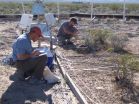(Press-News.org) SAN DIEGO, CA (April 6, 2014)—Researchers from Fox Chase Cancer Center have shown that NEDD9, a scaffolding protein responsible for regulating signaling pathways in the cell, promotes the growth and spread of epithelial ovarian cancer.
Previous studies have demonstrated the protein's importance in tumor invasion and spread of some lymphomas and many solid tumor types, including melanoma, neuroblastoma, and breast cancer, but its role in gynecological cancers has been poorly understood. The new data, to be presented on Sunday, April 6 at the AACR Annual Meeting 2014, suggest the protein activates known oncogenic signaling pathways in cancer cells, encouraging metastases.
"NEDD9 expression is usually associated with metastasis," says lead author Rashid Gabbasov, a graduate student in Fox Chase's Developmental Therapeutics Research Program and a researcher in the laboratory of Fox Chase Associate Professor Denise C. Connolly, PhD. "We've shown in two mouse models that expression of the protein probably plays an important role both in the initial development of ovarian cancer and tumor dissemination."
Because it lacks catalytic activity that might be inhibited, NEDD9 (neural precursor cell expressed, developmentally downregulated 9) itself is unlikely to be a suitable candidate for targeted therapy, says Gabbasov, and because it's not present in the blood it may not be suitable for diagnosing ovarian cancer. However, because the protein serves as a scaffolding molecule for other signaling proteins that play significant roles in cancer development and is important in several molecular pathways, it can inform future investigations of the biology of ovarian cancer in human cancer specimens. Researchers can investigate pathways downstream of the protein that are active in ovarian cancer to identify those which may be used as potential diagnostic or therapeutic biomarkers.
Epithelial ovarian cancer is diagnosed in more than 22,000 women every year. The disease kills about 14,000, according to the American Cancer Society. It is the fifth leading cause of cancer death in women and one of the most common gynecologic cancers. In most patients, the disease has already metastasized at the time of diagnosis.
Connolly, whose research focuses on understanding the molecular underpinnings of epithelial ovarian cancer, says she and her colleagues became interested in NEDD9 after learning about its role in other cancers. The protein was discovered in 1996 by Fox Chase Professor Erica A. Golemis, PhD, Co-Leader of the Center's Developmental Therapeutics Research Program and a co-author on the ovarian cancer study.
Proteins like NEDD9 control and regulate the signaling mechanisms between the surface and interior of a cell.
"At the time our research started, we saw an early report suggesting that high-level NEDD9 expression was part of a gene signature related to advanced stage ovarian cancer," says Connolly, senior author on the study.
To study the protein's role in epithelial ovarian cancer, Gabbasov and his colleagues compared tumor growth in two groups of mice bred to spontaneously develop ovarian tumors. Mice in one group lacked NEDD9, and mice in the other group expressed the protein. Using MRI scans, the researchers observed delayed tumor development in the NEDD9-null mice, compared to mice that expressed NEDD9. Analysis of tumor tissue showed more activity in several well-known oncogenic signaling pathways in the mice expressing the protein.
"When we compared the gene expression in these tumors, we were able to see how NEDD9 depletion really affects overall gene expression," says Gabbasov. "It really does affect numerous genes, and we will try to pursue these gene products to better understand the role of NEDD9."
Connolly says that even though this study looked at the ovarian cancer in mice, some of the genes that turned up in the gene expression analysis can be further evaluated in human cell lines and tumors. "We want to make sure we're studying something that's not only important in mice but can also give us clues about human cancers."
INFORMATION:
In addition to Gabbasov, Connolly and Golemis, coauthors of the study include Fox Chase Cancer Center researchers Laura E. Bickel, Shane W. O'Brien, and Samuel Litwin, as well as Sachiko Seo from the University of Tokyo in Japan, who developed the NEDD9 null mice.
Fox Chase Cancer Center, part of the Temple University Health System, is one of the leading cancer research and treatment centers in the United States. Founded in 1904 in Philadelphia as one of the nation's first cancer hospitals, Fox Chase was also among the first institutions to be designated a National Cancer Institute Comprehensive Cancer Center in 1974. Fox Chase researchers have won the highest awards in their fields, including two Nobel Prizes. Fox Chase physicians are also routinely recognized in national rankings, and the Center's nursing program has received the Magnet status for excellence four consecutive times. Today, Fox Chase conducts a broad array of nationally competitive basic, translational, and clinical research, with special programs in cancer prevention, detection, survivorship, and community outreach. For more information, visit Fox Chase's Web site at http://www.foxchase.org or call 1-888-FOX CHASE or (1-888-369-2427).
Scaffolding protein promotes growth and metastases of epithelial ovarian cancer
2014-04-07
ELSE PRESS RELEASES FROM THIS DATE:
Non-invasive imaging instead of repeated biopsy in active monitoring of prostate cancer
2014-04-06
Your body's cells have two major interconnected energy sources: the lipid metabolism and the glucose metabolism. Most cancers feed themselves by metabolizing glucose, and thus can be seen in Positron Emission Topography (PET) scans that detect radiolabeled glucose. However, prostate cancers tend to use the lipid metabolism route and so cannot be imaged in this way effectively. A University of Colorado Cancer Center study being presented today at the American Association for Cancer Research (AACR) Annual Meeting 2014 describes a novel method to "manipulate the lipid metabolism ...
Researchers find that renal cancer cells thrive when put in the right environment and supported by a specific enzyme
2014-04-06
SAN DIEGO, CA (April 6, 2014)—Tumor cells are picky about where they live. In the wrong environment, they fail to reach their potential. But put those same cells on the right bit of real estate, and they grow like mad. Researchers at Fox Chase Cancer Center found renal cancer cells planted in a supportive environment proliferate with the help of an enzyme usually only seen in the brain.
The enzyme, a specific isoform of a rather common kinase, may eventually become a target for cancer therapy as kinases constitute reasonably targetable enzymes, said Edna Cukierman, PhD, ...
Scripps Research Institute scientists provide new grasp of soft touch
2014-04-06
LA JOLLA, CA—April 6, 2014—A study led by scientists at The Scripps Research Institute (TSRI) has helped solve a long-standing mystery about the sense of touch.
The "gentle touch" sensations that convey the stroke of a finger, the fine texture of something grasped and the light pressure of a breeze on the skin are brought to us by nerves that often terminate against special skin cells called Merkel cells. These skin cells' role in touch sensation has long been debated in the scientific community. The new study, however, suggests a dual-sensor system involving the Merkel ...
Amino acid fingerprints revealed in new study
2014-04-06
VIDEO:
This animation shows the basic process of sequencing amino acids in a nanopore, using the technique of recognition tunneling.
Click here for more information.
Some three billion base pairs make up the human genome—the floor plan of life. In 2003, the Human Genome Project announced the successful decryption of this code, a tour de force that continues to supply a stream of insights relevant to human health and disease.
Nevertheless, the primary actors in virtually all ...
Scientists find potential drug targets in deadly pediatric brain tumors
2014-04-06
BOSTON, MA (April 6, 2014) -- Researchers studying a rare, always fatal brain tumor in children have found several molecular alterations that drive the cancer, according to a new study from scientists at Dana-Farber/Boston Children's Cancer and Blood Disorders Center and McGill University. The findings identify potential new targets for drug treatments.
The new research could help physicians choose targeted agents with a better chance of combating pediatric high-grade astrocytomas, which are extremely difficult to treat with radiation and surgery. The tumors have resisted ...
Field study shows why food quality will suffer with rising CO2
2014-04-06
For the first time, a field test has demonstrated that elevated levels of carbon dioxide inhibit plants' assimilation of nitrate into proteins, indicating that the nutritional quality of food crops is at risk as climate change intensifies.
Findings from this wheat field-test study, led by a UC Davis plant scientist, will be reported online April 6 in the journal Nature Climate Change.
"Food quality is declining under the rising levels of atmospheric carbon dioxide that we are experiencing," said lead author Arnold Bloom, a professor in the Department of Plant Sciences.
"Several ...
Researchers find arid areas absorb unexpected amounts of atmospheric carbon
2014-04-06
PULLMAN, Wash.—Researchers led by a Washington State University biologist have found that arid areas, among the biggest ecosystems on the planet, take up an unexpectedly large amount of carbon as levels of carbon dioxide increase in the atmosphere. The findings give scientists a better handle on the earth's carbon budget—how much carbon remains in the atmosphere as CO2, contributing to global warming, and how much gets stored in the land or ocean in other carbon-containing forms.
"It has pointed out the importance of these arid ecosystems," said R. Dave Evans, a WSU professor ...
Friedreich's ataxia -- an effective gene therapy in an animal model
2014-04-06
The transfer, via a viral vector, of a normal copy of the gene deficient in patients, allowed to fully and very rapidly cure the heart disease in mice. These findings are published in Nature Medicine on 6 April, 2014.
Friedreich's ataxia is a severe, rare hereditary disorder which combines progressive neuro-degeneration, impaired heart function and an increased risk of diabetes. The condition affects one in every 50,000 birth. There is currently no effective treatment for this disease. In most cases, Friedreich's ataxia starts in adolescence with impaired balance and ...
Smoking visibility mapped for the first time
2014-04-06
The visibility of smoking in city streets has for the first time anywhere been mapped, in new research from the University of Otago, Wellington, New Zealand.
The research found that up to 116 smokers outside bars/cafés could be seen from any one location in the outdoor public areas of downtown Wellington (e.g. on a footpath). Of 2600 people observed in the outdoor areas of bars and cafés, 16% were smoking, with a higher proportion than this in evenings.
Data from observations across the downtown area were mapped by the researchers, producing a record of the street ...
Blood test could provide rapid, accurate method of detecting solid cancers
2014-04-06
STANFORD, Calif. — A blood sample could one day be enough to diagnose many types of solid cancers, or to monitor the amount of cancer in a patient's body and responses to treatment. Previous versions of the approach, which relies on monitoring levels of tumor DNA circulating in the blood, have required cumbersome and time-consuming steps to customize it to each patient or have not been sufficiently sensitive.
Now, researchers at the Stanford University School of Medicine have devised a way to quickly bring the technique to the clinic. Their approach, which should be broadly ...





